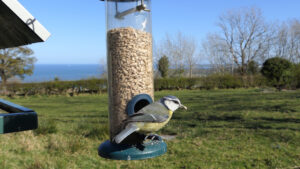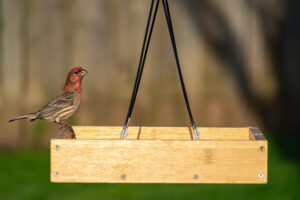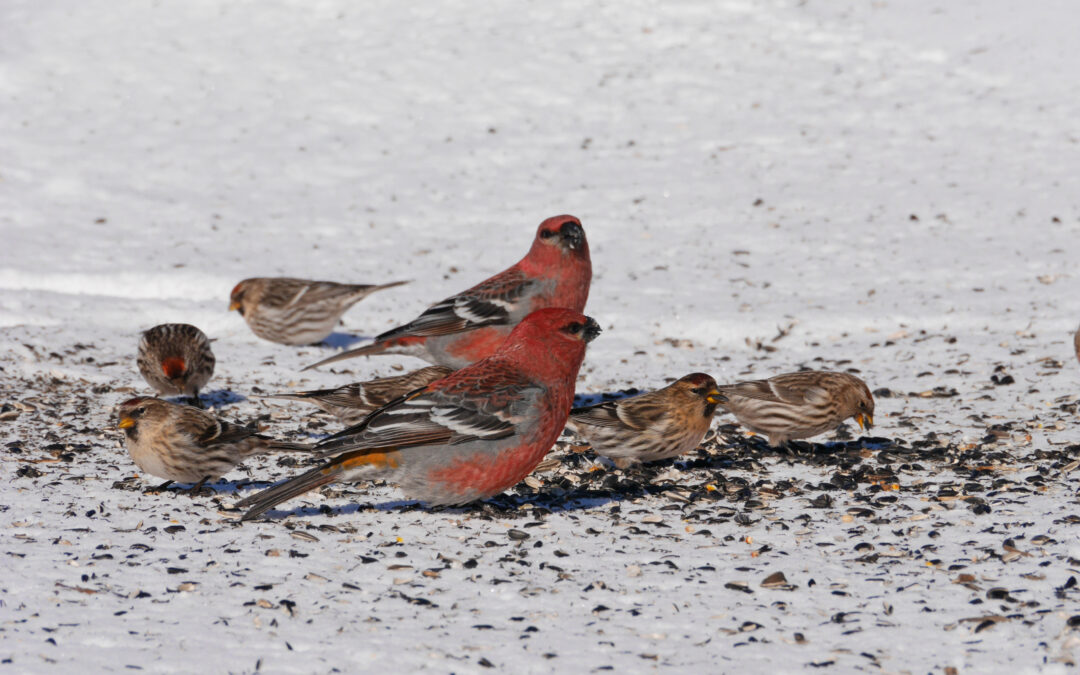==================
A Caveat and Affiliates
First off, a little caveat: within my articles you will find affiliate links, meaning if you buy them, I get a small commission. Your cost is not affected. In addition, I am an Amazon Associate and I earn from qualifying purchases on Amazon.
And yes, if I say that I recommend a product here, it means I truly believe it is a good product. I refuse to recommend any product that I have not researched and believe to be a good value.
Even better, I provide you with a very clear picture of the product, it’s use, and the probable value.
Earning your trust is important to me. I run this website myself and the commissions and donations help support the site.
Sound reasonable and fair enough? Let’s continue to the article.
==================
Of course, this all depends on many factors, such as how you manage your bird feeders and shelters. In this blog, you will learn effective ways to attract winter birds. But for starters, let me introduce you to some of the most common winter birds that love to visit our backyards.
Common Backyard Winter Birds
The geography and habitat around your home can affect the species of winter birds that would visit your feeders. In the US, there are bout 35 to 40 species of winter birds. Most of these are found in the forested countryside and few visits to built-up areas.
Some winter birds can be regular backyard visitors, while others will only be present during winter. On the northeast coast of America, one suburban yard manages to attract over 20 species of snow birds during winter. This diversity is clearly a result of the ample trees and shrubs, as well as the number of heated birdbaths and feeders in the area.
Still, irregularities can happen especially when there’s an irruption of a particular winter bird species. These are the common bird species that could pay your feeder a visit in the winter:
- Finches
- Goldfinches
- Robins
- Chickadees
- Waxwings
- Redpolls
- Hawks
- Sparrow
- Juncos
- Starlings
- Grosbeaks
- Kinglets
- Woodpeckers
- Doves
- Cardinals
- Mockingbirds
- Siskins
- Nuthatches
- Crossbills
- Pigeons
- Owls
- Titmice
- Warblers
- Buntings
- Longspurs
Feeding birds is great for brightening a dreary winter day. In the non-breeding season, birds are mostly less territorial and would tolerate sharing space with other species. If your backyard meets their needs, you’ll be able to enjoy their bustles, colors, and songs in the midst of a few flurries.
Now it’s time to learn some tricks for attracting winter birds and enjoy bird-watching in winter.
Aim at Feeders
Although birds’ feathers puff up in winter, they still have to take in high-fat foods to keep their body heat. For this reason, feeders with fat-rich foods are beneficial. Since your focus is to attract different types of winter birds, consider having more than one type of feeder.
Having different types of feeders increases the chance of attracting various types of winter birds. The ideal feeder is sturdy yet easy to assemble. This helps maintenance, such as cleaning, become convenient. For reference, check the three main types of feeders—house, tube, and platform feeders.

Hopper. Hoppers are house-shaped feeders with plexiglass sides serving as seed dispensers. Along with the side trays and perches where birds eat. Its see-through glass sides make it easier to tell when to add seeds. Although they’re good at protecting seeds against weather, they don’t do well against looting critters.

Tube feeder. A hanging cylindrical feeder that can either be glass or wire mesh. It has multiple feeding ports where birds peck seeds. The port size of glass feeders depends on what birds you want to feed.
Tube feeders with regular-size ports attract medium-sized beaks while the ones with tiny ports attract smaller birds. Better have both options to attract both types of birds. Glass tube feeders also have perches where birds roost and wire mesh tubers allow birds to cling to the wires.
You can put a plastic dome above the feeder to protect seeds and feeding birds from the snow. Or attach a tray to the bottom to keep the seeds from falling onto the ground.

Platform feeders. As the name implies, platform or tray feeders have flat, suspended bases. It usually has side pieces to prevent bird seeds from spilling over. Though some tray feeders are pole-anchored.
Birds that naturally find food on the ground feed on this type of feeder. Platforms feeders are the most common and easy to make. But having a non-exclusive feeder comes with a disadvantage, such as not being weatherproof and the need for constant cleaning to remove bird droppings. Aside from these three, there are other types of feeders purposely designed for different bird foods like suet, thistle, peanuts, mealworms, and fruit.
In addition to finding the right types of feeders, selecting the right location for them will increase your chance of successful winter bird feeding. When selecting a site for establishing your bird feeders, consider the following:
- Distance From Windows
- Feeder Pole
- Baffle
- Feeders High
- Shrubs
Feeders should be visible from inside the house. Placing feeders 10 feet from your window is ideal, along with protective covering such as trees and shrubs. Speaking of shrubs, they are vital for keeping birds safe from common predators like hawks and owls. Having a cover also helps attract regular feeder visitors since most birds don’t venture from things that can protect and rest them.
| Winter Bird Species | Favored Feeder |
| American Goldfinch | Niger feeder, hanging tube feeder, ground |
| Black-capped chickadee | Almost all feeders |
| Blue jay | Platform feeder |
| Brown-headed cowbird | Platform feeder |
| Carolina wren | Suet feeder |
| Common grackle | Platform feeder, a tube feeder with a tray |
| Dark-eyed junco | Ground, platform feeder |
| Downy and hairy woodpeckers | Suet feeder, hanging feeder |
| European starling | Suet feeder, platform feeder |
| House finch | Niger feeder, hanging tube feeder, ground |
| House sparrow | Platform feeder, a tube feeder with a tray |
| Mourning dove | Ground, platform feeder |
| Northern cardinal | Ground, platform feeder, a tube feeder with tray |
| Purple finch | Niger feeder, hanging tube feeder |
| Red-bellied Woodpecker | Suet feeder, hanging feeder |
| Red-breasted nuthatch | Suet feeder, hanging feeder |
| Song sparrow | Ground, platform feeder |
| Tufted titmouse | Hanging feeder, suet feeder |
| White-breasted nuthatch | Almost all feeders |
| White-throated sparrow | Ground, platform feeder |
Winter Bird Feeding—More Seeds
The seed you provide will affect the number of birds that will visit your feeder. Don’t settle for less. There are over 20 sorts of seeds to choose from. The most in-demand of all is the small black-oil sunflower seed. If you want to go for a single seed, then choose this one. It might be a bit pricier than others, but almost all kinds of birds eat black-oil sunflower seed. Plus, it’s easy to crack open and provides a high level of nutritious oil.
Another type of popular sunflower seed is the striped sunflower seed. However, since it is larger compared to black-oil sunflowers, smaller birds would struggle to crack it open.
Sunflower seeds might be essential, but there’s still a drawback. For birds to eat them, they need to crack the seeds open, leaving a mess of hulls under the feeder. If you want to avoid this, opt for the more expensive hulled sunflower seeds. These seeds are stripped from their coats, which would leave no mess.
To attract even more species, try providing an array of food besides sunflower seeds. White proso millet, nyger, and peanuts are other types of popular seeds you want to include in your feeder.
White proso millet is affordable and can attract most winter bird species. Nyger or thistle seeds are known to attract rare species of birds in winter. Due to their minute size, nyger seeds are mostly dispensed in feeders with tiny feeding ports. Peanuts, on the other hand, can be offered as shelled kernels or as peanut hearts. Peanut hearts allow smaller species of birds to eat easily.
If you are still having a problem figuring out what seeds you should choose, why not have most of them? Many shops sell mixed bird seeds containing a variety of seeds in one pack. Yet, before you buy one, check the seed content. Some cheap mixes contain seeds and grains that will turn off winter birds. Among these are wheat, milo, hulled oats, rice, and rye. If your bird feeder encompasses these mixtures, then they’ll easily be leftovers.
More Bird Food
Apart from the seeds, there are other foods you can include to level up your feeder. One vital food includes suet. Suet is a fatty substance made from oil or lard that is favored by birds in winter. You can buy suet from your local grocery store or at a nearby pet shop. Suet can be inserted on mesh wire or on specific suet feeders. There is also suet that is processed into cakes. These cakes are made to stay edible during warmer weather. They also contain a mix of fruits and seeds.
| Winter Bird Species | Favored Food |
| American Goldfinch | Niger, sunflower seeds |
| Black-capped chickadee | Sunflower seeds, suet, peanuts |
| Blue jay | Sunflower seeds, suet, peanuts |
| Brown-headed cowbird | Millet |
| Carolina wren | Peanut butter, suet |
| Common grackle | Cracked corn, sunflower seeds |
| Dark-eyed junco | Sunflower seeds, millet |
| Downy and hairy woodpeckers | Suet, sunflower seeds, peanuts |
| European starling | Peanut butter, suet, sunflower seeds |
| House finch | Niger, sunflower seeds, millet |
| House sparrow | Niger, sunflower seeds |
| Mourning dove | Cracked corn, millet, sunflower seeds |
| Northern cardinal | Sunflower seeds, seed mixes |
| Purple finch | Niger, sunflower seeds, millet |
| Red-bellied Woodpecker | Suet, sunflower seeds, peanuts |
| Red-breasted nuthatch | Sunflower seeds, suet |
| Song sparrow | Sunflower seeds, millet |
| Tufted titmouse | Sunflower seeds, suet, peanuts |
| White-breasted nuthatch | Sunflower seeds, suet |
| White-throated sparrow | Sunflower seeds, millet |
Winter Bird Feeding—Supplying Water
Along with feeders and food, supplying bird baths and drinking water will also attract winter birds. Water can even attract birds that don’t usually visit backyards. This is because cold temperatures cause natural water sources to freeze and become inconvenient.

Regarding bird baths, you have a homemade birdbath or buy it at your local garden stores. Ideally, your birdbath should have a heater to keep the water from freezing. The high and the location of your bird bath can affect the species that will be attracted to it. Additionally, place your birdbath away from dense bushes to prevent predators from ambushing the bathing birds.
Roosting Boxes and Shelters

Shelters like roosting boxes offer convenience not only during nesting season but also as roosting sites during harsh weather. These bird shelters provide warmer rooms compared to the cold outside. Cavities in trees and thickets of confiners are natural options for giving winter birds roosting refuge.
Winter Bird Feeding—Why birds don’t visit your feeders
There can be a lot of factors as to why birds don’t visit your feeders. First, your feeders are placed in spots that make it hard for birds to find. Second, the seeds you supplied might not be attractive to birds. Third, the abundance of winter birds in your area could be lesser than usual. If one or more of these reasons is the cause of your problem, take time to do some additional research or contact a local wildlife official in your area.
